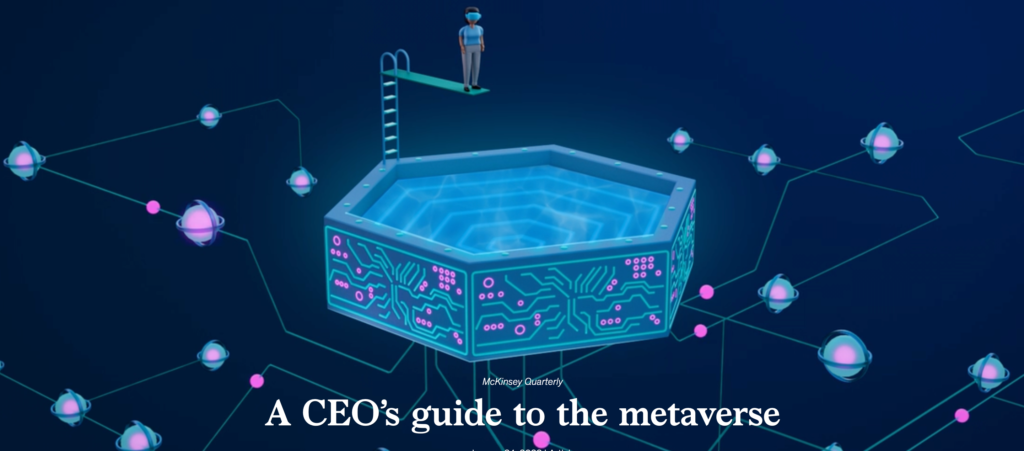Via By Homayoun Hatami, Eric Hazan, Hamza Khan, and Kim Rants, McKinsey Quarterly
Suddenly, the metaverse is in the zeitgeist, for better or worse. Investment more than doubled in 2022 powered by big moves (such as Microsoft’s $69 billion acquisition of Activision Blizzard, now under antitrust review) and small ones (about $12 billion to $14 billion of venture capital and private equity investment). Everyone has heard about the successes racked up by some big gaming companies: Roblox reported more than 58 million daily active users in 2022,1 while Fortnite had more than 20 million in 2020 and generated more than $9 billion in sales between 2018 and 2019.2 And others are investing; Meta continues to spend at least $10 billion annually on metaverse development. Yet investors are asking questions of metaverse companies about when they can expect tangible, near-term results from these companies’ investments.
How should CEOs view the metaverse? Is it a big opportunity or a big risk? Our answer: the opportunity is enormous—and the risk is not what you think it is. The companies that are building the metaverse see it as the next iteration of the internet (see this McKinsey Explainer for more). And as with any technology so vast and all-encompassing (it’s similar to AI in its scope), the potential is enormous. We estimate that the metaverse could generate $4 trillion to $5 trillion in value by 2030; see our report for all the details.
The case for optimism
When we estimated the market value of metaverse activity in June 2022, we calculated that it was between $200 billion and $300 billion. It’s larger now, and in eight years or so, it could be $4 trillion to $5 trillion (exhibit), which is roughly the size of Japan’s economy, the third largest in the world. Exponential growth is possible because of an alignment of several forces: the metaverse’s appeal spans genders, geographies, and generations; consumers have already shown they are ready to spend on metaverse assets; they are open to adopting new technologies; companies are investing heavily in the required infrastructure; and brands experimenting in the metaverse are finding that customers are delighted.
The sheer scale compels CEO attention. As the old saying goes, a billion here and a billion there, and pretty soon you’re talking about real money—and $5 trillion is a lot of billions. For context, we estimate that the road to net zero will require $3.5 trillion in annual spending and that the ongoing shift to the cloud holds an opportunity for an additional $3 trillion.
The number we’ve put on the metaverse’s potential is so large because the metaverse is a combinatorial technology: it combines elements of many of the top trends that the McKinsey Technology Council identified this year as most promising, including AI, immersive reality, advanced connectivity, and Web3. That’s the main reason CEOs should be interested; another is that the metaverse touches on many parts of the enterprise. The CEO is the natural integrator who can marshal the company’s resources to put together a coherent, value-driven response. And with the CEO’s support, there’s less chance that the metaverse effort gets stuck in “pilot purgatory.”
…
A long way to go
Skeptics note that other technologies have sometimes taken a surprisingly long time to arrive at their commercial potential. AI is one; even after a decades-long “AI winter,” many analysts believe that AI still has not reached its potential, though the recent advances in generative AI are bringing many skeptics around. Autonomous vehicles are another. Isn’t there a risk that the metaverse will suffer a similar fate? Put another way, where are we on the hype cycle? Peak of inflated expectations? Or headed into the trough of disillusionment?
In our view, the development of the metaverse is a few years away from a true tipping point. It could easily take longer (though that’s no reason not to prepare).
As Brian Solis of Salesforce shared with us recently, generational changes like Web 1.0, social media, and mobile “rarely happen overnight. They take years and are the result of an accumulation of incremental technological advances, evolving consumer demand, and cycles of experimentation.” That seems an apt description of the hurdles that the metaverse must overcome.
“Generational changes like Web 1.0, social media, and mobile rarely happen overnight. They take years and are the result of an accumulation of incremental technological advances, evolving consumer demand, and cycles of experimentation.”
The technology is not yet ready to support the metaverse at scale: advances in 5G networks, edge computing, hardware, and software must come online (they’re in progress). At the moment, audiences are primarily gamers and the technically savvy; others must be recruited (our surveys suggest they’re very interested). Many metaverse transactions are made in cryptocurrency; we’ve all seen the shortcomings of crypto as a reliable, safe system of exchange. Finally, there is no connection among all the various partial metaverses (Roblox, the Sandbox, and many others). The integrated or true metaverse is a long way off.
Please click here for the article in its entirety.
Please read McKinsey’s interview with Brian Solis about the Metaverse here.
About the Authors
Homayoun Hatami is the managing partner for global client capabilities and a senior partner based in McKinsey’s Paris office, where Eric Hazan is a senior partner. Hamza Khan is a partner in the London office. Kim Rants is an associate partner in the Copenhagen office. The authors wish to thank Nikita Pillai and Adam Ridemar for their contributions to this article.







Leave a Reply